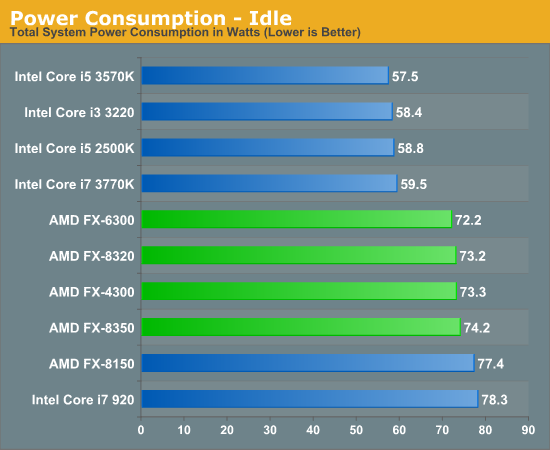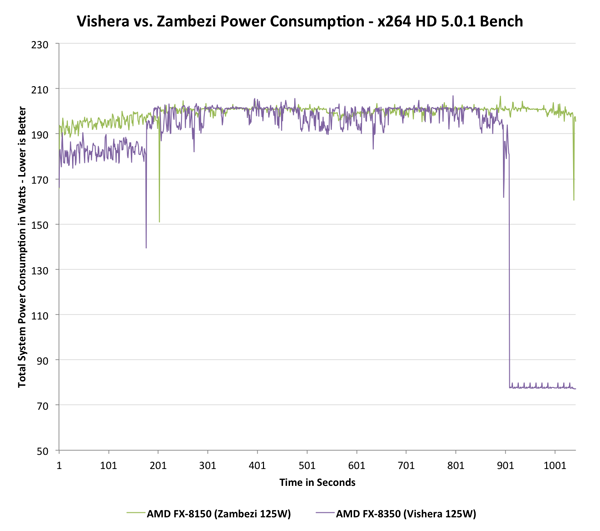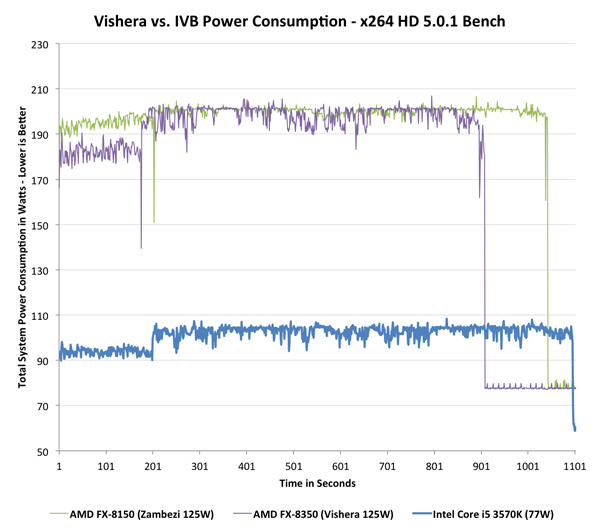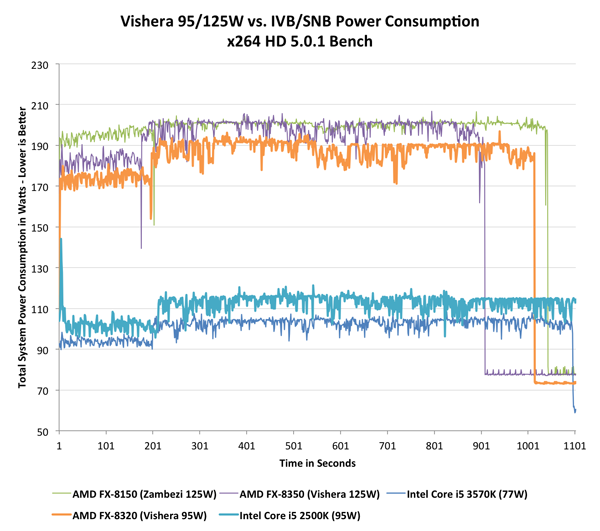The Vishera Review: AMD FX-8350, FX-8320, FX-6300 and FX-4300 Tested
by Anand Lal Shimpi on October 23, 2012 12:00 AM ESTPower Consumption
With Vishera, AMD was in a difficult position: it had to drive performance up without blowing through its 125W TDP. As the Piledriver cores were designed to do just that, Vishera benefitted. Remember that Piledriver was predominantly built to take this new architecture into mobile. I went through the details of what makes Piledriver different from its predecessor (Bulldozer) but at as far as power consumption is concerned, AMD moved to a different type of flip-flop in Piledriver that increased complexity on the design/timing end but decreased active power considerably. Basically, it made more work for AMD but resulted in a more power efficient chip without moving to a dramatically different architecture or new process node.
In mobile, AMD used these power saving gains to put Piledriver in mobile APUs, a place where Bulldozer never went. We saw this with Trinity, and surprisingly enough it managed to outperform the previous Llano generation APUs while improving battery life. On desktops however, AMD used the power savings offered by Piledriver to drive clock speeds up, thus increasing performance, without increasing power consumption. Since peak power didn't go up, overall power efficiency actually improves with Vishera over Zambezi. The chart below illustrates total system power consumption while running both passes of the x264 HD (5.0.1) benchmark to illustrate my point:
In the first pass Vishera actually draws a little less power, but once we get to the heavier second encode pass the two curves are mostly indistinguishable (Vishera still drops below Zambezi regularly). Vishera uses its extra frequency and IPC tweaks to complete the task sooner, and drive down to idle power levels, thus saving energy overall. The picture doesn't look as good though if we toss Ivy Bridge into the mix. Intel's 77W Core i5 3570K is targeted by AMD as the FX-8350's natural competitor. The 8350 is priced lower and actually outperforms the 3570K in this test, but it draws significantly more power:
The platforms aren't entirely comparable, but Intel maintains a huge power advantage over AMD. With the move to 22nm, Intel dropped power consumption over an already more power efficient Sandy Bridge CPU at 32nm. While Intel drove power consumption lower, AMD kept it constant and drove performance higher. Even if we look at the FX-8320 and toss Sandy Bridge into the mix, the situation doesn't change dramatically:
Sandy Bridge obviously consumes more than Ivy Bridge, but the gap between a Vishera and any of the two Intel platforms is significant. As I mentioned earlier however, this particular test runs quicker on Vishera however the test would have to be much longer in order to really give AMD the overall efficiency advantage.
If we look at average power over the course of the two x264 encode passes, the results back up what we've seen above:

As more client PCs move towards smaller form factors, power consumption may become just as important as the single threaded performance gap. For those building in large cases this shouldn't be a problem, but for small form factor systems you'll want to go Ivy Bridge.
Note that idle power consumption can be competitive, but will obviously vary depending on the motherboard used (the Crosshair Formula V is hardly the lowest power AM3+ board available):














250 Comments
View All Comments
MySchizoBuddy - Tuesday, October 23, 2012 - link
correct for your workload AMD is a better choice in speed and costBlibbax - Tuesday, October 23, 2012 - link
Read the techreport review. Intel still comes out on top.CeriseCogburn - Tuesday, October 30, 2012 - link
Don't worry AMD is going to SteamRoll Intel soon !CeriseCogburn - Tuesday, October 30, 2012 - link
NO, amd never does better. It does worse, often by a lot, and sad little cheapo SB's spank it sorry a lot of the time.Mugur - Tuesday, October 23, 2012 - link
I'm trying to find a good scenario for those desktop cpus... Cheap 8 core virtualization hosts? Video encoding? Other than that, in this "mobile" world when every desktop PC looks out of time, I don't know what you can do with them. They are obviously not good for light loads or gaming...lmcd - Tuesday, October 23, 2012 - link
The architecture makes more sense when less modules are used, i.e. the APU series. Look at how Trinity destroyed Llano, both desktop and mobile. And note that an A10+6670 is a perfect midrange gaming value.CeriseCogburn - Tuesday, October 30, 2012 - link
fanboy much ? Now we have again the amd perfection. LOLSB smacks it down, as does nVidia. Sorry fanboy, amd has nothing that is a perfect value, especially in gaming.
RussianSensation - Tuesday, November 6, 2012 - link
What are you blabbing about? You should be banned from this forum.While Intel's CPUs are clearly in a class of their own for high-end CPU gaming rigs, AMD's GPUs are doing very well this generation, having captured single-GPU performance crown, performance/$ and overclocking performance. The minute you said NV smacks AMD's GPU around, you lost ALL credibility.
http://www.techpowerup.com/reviews/AMD/Catalyst_12...
You may want to take a look at 90% of all the games that came out in 2012 - GTX680 loses to 7970 GE (or 680 OC vs. 7970 OC). Facts must not sit well with AMD haters.
mayankleoboy1 - Tuesday, October 23, 2012 - link
Nice performance predictions for Haswell and Steamroller.But IMHO, 15% increase for Haswell is too high and 15% for Steamroller is low.
IMHO, more realistic expectations would be :
Haswell 10%. probably more like 8%.
Steamroller 20%
dishayu - Tuesday, October 23, 2012 - link
Steamroller 15% is straight from the horse's (AMD's) mouth and 15% for Haswell is well within reason because it's a "tock" (new architecture). So, i think 15% for both works out fine for making speculative statements at this moment.